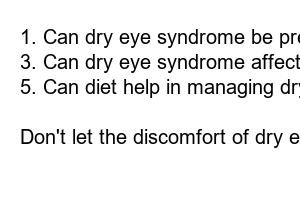안구건조증 치료 방법
Title: Understanding and Treating Dry Eye Syndrome: Your Ultimate Guide
Introduction:
Dry eye syndrome is a common condition that affects millions of people worldwide. It occurs when the eyes fail to produce enough tears or when the tears evaporate too quickly. This can lead to discomfort, itching, redness, and even blurred vision. In this comprehensive guide, we explore the causes, symptoms, and effective treatments for dry eye syndrome.
1. What Causes Dry Eye Syndrome?
Dry eye syndrome can be caused by various factors, including age, certain medications, medical conditions like diabetes, environmental factors, and prolonged computer or screen usage. These factors can disrupt the normal production and quality of tears, leaving your eyes dry and irritated.
2. Recognizing the Symptoms of Dry Eye Syndrome:
* Persistent dryness and discomfort in the eyes
* Burning or stinging sensation
* Excessive tearing or watery eyes
* Sensitivity to light
* Blurred or fluctuating vision
* Feeling of something gritty or foreign in the eyes
3. Simple Steps to Relieve Dry Eye Symptoms:
a) Blink Regularly: Remember to blink frequently, especially when using digital devices or working in a dry environment.
b) Use a Humidifier: Adding moisture to the air can help alleviate dry eye symptoms.
c) Practice the 20-20-20 Rule: Take breaks from screen time every 20 minutes and focus on an object 20 feet away for 20 seconds to reduce eye strain.
d) Avoid Smoke and Irritants: Stay away from cigarette smoke and other irritants that can exacerbate dry eye symptoms.
e) Stay Hydrated: Drink plenty of water to maintain overall hydration, which also helps keep your eyes moist.
4. Over-the-Counter Remedies for Dry Eye Syndrome:
Artificial tears and eye lubricants available over-the-counter are effective in providing temporary relief from dry eye symptoms. These products mimic the natural tears, offering lubrication and soothing the eyes, providing immediate comfort.
5. Prescription Medications and Treatments:
In severe cases of dry eye syndrome, your eye care professional might recommend prescription medications such as cyclosporine or lifitegrast. These can help reduce inflammation and increase tear production. Other treatments like punctal plugs, which block the tear ducts to retain moisture, or intense pulsed light therapy can also be considered.
6. Consultation with an Eye Care Professional:
If home remedies are not relieving the discomfort or if symptoms worsen, it is crucial to seek professional advice from an eye care specialist. They will assess your condition, determine the underlying cause, and recommend suitable treatment options tailored to your specific needs.
FAQs:
1. Can dry eye syndrome be prevented?
2. Is it necessary to consult a doctor for dry eye syndrome?
3. Can dry eye syndrome affect one eye only?
4. How long does it take to notice improvement with prescribed medications?
5. Can diet help in managing dry eye syndrome?
6. What are some alternative therapies for dry eye syndrome?
Summary:
Don’t let the discomfort of dry eye syndrome impact your daily life. By understanding the causes, recognizing the symptoms, and implementing simple changes in your routine, you can effectively manage and treat this condition. Remember, if home remedies don’t provide relief, consult an eye care specialist for a personalized treatment plan. Take care of your eyes, and enjoy clear, comfortable vision every day.

